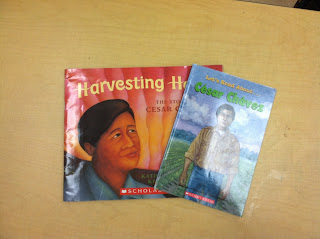I am always browsing around looking for new ideas to use in my classroom. One of the things I have come across, mostly on homeschooling sites are Lapbooks. I like the idea of kids working on a concept over a period of time and compiling them in a Lapbook. I decided to use the idea with genre study on biographies. I found some templates for different types of foldables to incorporate into the project.
I started out by reading my 3rd graders the picture book biography of Amelia Earheart by David Adler. I created a timeline using chart paper and modeled using a think aloud as I read how to pull out important events in Amelia's life out of the text. ( the I do part of the lesson), After that, we worked together to decide what else should be included on our timelines. I marked various stopping points in the text and had them discuss with their "turn and talk" partners about the key events from each section. I circulated throughout the groups as they discussed and jotted down ideas they shared. After a brief discussion, we came back together and decided which events were the most important and recorded them on the class timeline. We looked at the structure of the biographies and talked about how the story was organized in chronological order.
For the independent practice portion, I let the kids choose their own biography to read for their Lapbook project. I have a book bin that contains about 50 different biographies (The Goodwill Bookstore is the best place ever) that range in complexity in order to differentiate for the varying ability levels of my students. I tried to include a variety of books that would interest my students. I really like the Who was....series of biographies as well as the picture book biographies written by David Adler. As they were reading, they recorded key dates in their person's life using a timeline graphic organizer. I reviewed the timelines individually with each student. They had to have their timeline approved prior to beginning their final draft. We took the information from and created pop out timelines for their Lapbooks using an Accordian foldable. On each panel they included the key dates and events from their person's life and illustrated each one. I am very pleased how they turned out.
Under the timeline they glued a book pocket. They had to find keywords/vocabulary related to their books. They wrote each vocabulary word on the front and a definition of the word on the back. On the center panel, they are including Bio Poems about their person that they chose to read about. We also included a "wheel" of interesting facts about their person. We aren't quite done yet, but they will include a section on important achievements and their significance, and quotes. I will post the links for the foldable templates and some examples of their finished products. The kids in my class are really loving this project. I will also post the rubric I designed to assess their final projects. I am loving it because the kids have taught me about some really fascinating people.










